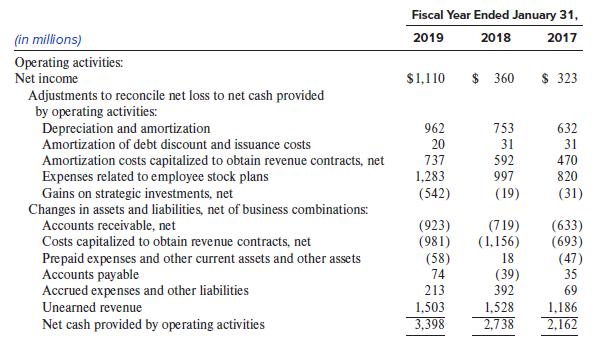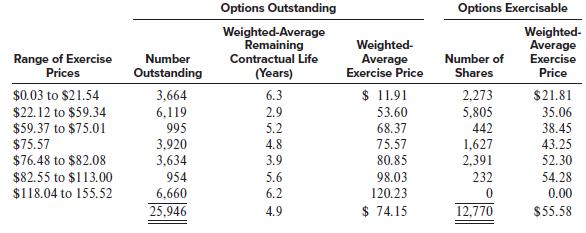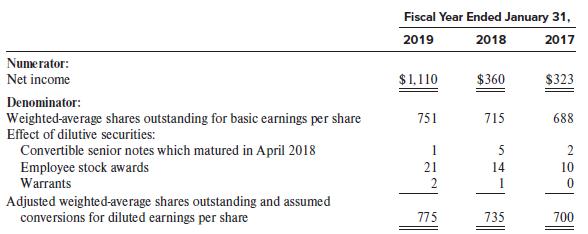Refer to the salesforce.com financial statement excerpts given below to answer the questions. On January 31, 2019,
Question:
Refer to the salesforce.com financial statement excerpts given below to answer the questions. On January 31, 2019, the price of salesforce.com stock was $151.97, and there were 770 million shares of common stock outstanding. The price of its stock on January 31, 2018, was $113.91. All questions relate to the fiscal year ended January 31, 2019, unless stated otherwise.


Notes to Consolidated Financial Statements
1. Summary of Business and Significant Accounting Policies Description of Business
Salesforce.com, inc. (the “Company”) is a leading provider of enterprise software, delivered through the cloud, with a focus on customer relationship management, or CRM. The Company introduced its first CRM solution in 2000, and has since expanded its service offerings into new areas and industries with new editions, features and platform capabilities.
Stock-Based Expense
The Company recognizes stock-based expenses related to stock options and restricted stock awards on a straight-line basis, net of estimated forfeitures, over the requisite service period of the awards, which is generally the vesting term of four years.
10. Stockholders’ Equity
The Company maintains the following stock plans: the ESPP, the 2013 Equity Incentive Plan and the 2014 Inducement Equity Incentive Plan (“2014 Inducement Plan”).
As of January 31, 2019 and January 31, 2018, $76 million and $63 million, respectively, was withheld on behalf of employees for future purchases under the ESPP and is recorded in accrued compensation.
From February 1, 2006 through July 2013, options issued had a term of five years. After July 2013, options issued have a term of seven years.
The fair value of each stock option grant was estimated on the date of grant using the Black–Scholes option pricing model with the following assumptions and fair value per share:

The Company estimated its future stock price volatility considering both its observed option-implied volatilities and its historical volatility calculations. Management believes this is the best estimate of the expected volatility over the expected life of its stock options and stock purchase rights.
The estimated life for the stock options was based on an analysis of historical exercise activity.
The risk-free interest rate is based on the rate for a U.S. government security with the same estimated life at the time of the option grant and the stock purchase rights.
The estimated forfeiture rate applied is based on historical forfeiture rates. The Company does not anticipate paying any cash dividends in the foreseeable future and therefore uses an expected dividend yield of zero in the option pricing model. Stock activity excluding the ESPP is as follows:

The total intrinsic value of the options exercised during fiscal 2019, 2018 and 2017 was $784 million, $373 million and $224 million, respectively. The intrinsic value is the difference between the current market value of the stock and the exercise price of the stock option. The weighted-average remaining contractual life of vested and expected to vest options is approximately 5 years.
As of January 31, 2019, options to purchase 12.8 million shares were vested at a weighted average exercise price of $55.58 per share and had a remaining weighted-average contractual life of approximately 4 years. The total intrinsic value of these vested options as of January 31, 2019, was $1.2 billion.
During fiscal 2019, the Company recognized stock-based expense related to it equity plans for employees and non-employee directors of $1.3 billion. As of January 31, 2019, the aggregate stock compensation remaining to be amortized to costs and expenses was approximately $2.5 billion. The Company will amortize this stock compensation balance as follows: $1.2 billion during fiscal 2020; $0.8 billion during fiscal 2021; $453 million during fiscal 2022; $108 million during fiscal 2023 and $8 million during fiscal 2024. The expected amortization reflects only outstanding stock awards as of January 31, 2019 and assumes no forfeiture activity.
The aggregate stock compensation remaining to be amortized to costs and expenses will be recognized over a weighted average period of 2 years.
The following table summarizes information about stock options outstanding as of January 31, 2019:

12. Earnings Per Share Basic earnings per share is computed by dividing net income by the weighted-average number of common shares outstanding for the fiscal period. Diluted earnings per share is computed by giving effect to all potential weighted average dilutive common stock, including options, restricted stock units, warrants and the convertible senior notes. The dilutive effect of outstanding awards and convertible securities is reflected in diluted earnings per share by application of the treasury stock method.
A reconciliation of the denominator used in the calculation of basic and diluted earnings per share is as follows (in millions):

The weighted-average number of shares outstanding used in the computation of diluted earnings per share does not include the effect of the following potential outstanding common stock. The effects of these potentially outstanding shares were not included in the calculation of diluted earnings/loss per share because the effect would have been anti-dilutive (in millions):

Required:
1. What amount of stock-based compensation expense did salesforce.com recognize in 2019? Where is this expense reported in the income statement?
2. What are the main reasons that its Net income is $1,110 million, but its Net cash provided by operating activities is $3,398 million?
3. What is the amount of total compensation cost for the stock options granted by salesforce .com during fiscal 2019? Why is this amount not equal to the compensation expense from requirement 1?
4. Fiscal year 2019 stock options are valued at $28.89. Use an option pricing calculator to verify this calculation. Assume that the exercise price at date of grant equals the stock price at date of grant.
5. Explain why the $28.89 average fair value of stock options granted in 2019 exceeds the $23.64 average fair value of stock options granted in 2018.
6. Note 10 states that the Aggregate intrinsic value of exercisable options is $1,231 million. Show how salesforce.com would have computed this amount. What is the difference in meaning between exercisable and outstanding? Compute the ratio of Aggregate intrinsic value of outstanding options to the market value of common stock.
7. Assume that all of the options exercised in 2019 are treated as nonqualified options for tax purposes. Compute the tax benefit that salesforce.com received from the option exercise. Label your calculations.
8. Refer to Note 12. Explain how stock awards affected the numerators and denominators in both basic and diluted EPS.
9. Refer to Note 12. Explain why the dilutive effects of some securities were not included in the calculation of diluted EPS.
Step by Step Answer:

Financial Reporting And Analysis
ISBN: 9781260247848
8th Edition
Authors: Lawrence Revsine, Daniel Collins, Bruce Johnson, Fred Mittelstaedt, Leonard Soffer





